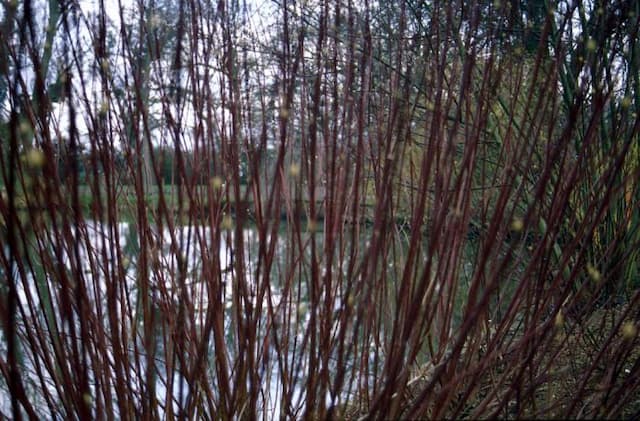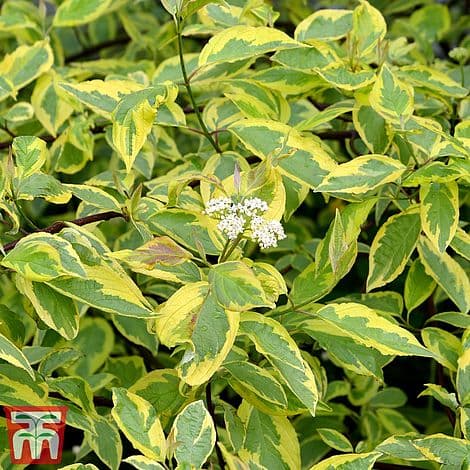Red Osier Dogwood Cornus sericea Kelsey's Gold = 'Rosco'
![red osier dogwood [Kelsey's Gold]](/_next/image?url=https%3A%2F%2Fplants-admin.emdemapps.com%2Fimages%2Fplants%2F%2Fimages%2F604b545042f1f.png&w=3840&q=75)
ABOUT
Cornus sericea 'Kelsey's Gold', commonly known as Red Osier Dogwood, is a vibrant and attractive shrub that captivates the eye with its distinctive features. This variety of dogwood distinguishes itself with its bright, golden-yellow leaves that glow warmly, lighting up the landscape with a splash of color. The leaves have a simple shape, displaying pointed tips and pronounced veins, creating a textured and lush appearance. During the growing season, small clusters of white flowers emerge, providing a pleasing contrast against the golden foliage. These blooms attract attention in the spring and early summer with their modest yet refreshingly elegant appeal. As the seasons change, the shrub bears white to bluish berries that add another layer of visual interest to the plant. One of the most striking characteristics of the Red Osier Dogwood is its vibrant red stems, which become especially pronounced during the winter months. Once the leaves have fallen, the bold red bark stands out starkly against snowy landscapes or grey skies, bringing a welcome burst of color to the quieter winter garden. The stems have a smooth texture and are straight and slender, creating a dense, bushy appearance for the shrub. The overall aspect of this dogwood is one of brightness and cheerfulness throughout the year, with a robust and full-bodied presence that adds both color and texture to any garden space. With its ever-changing palette from the fresh greens and white in spring and summer to the glowing golds and reds in autumn and winter, the Red Osier Dogwood truly is a plant that maintains interest across seasons.
About this plant
 Names
NamesFamily
Cornaceae.
Synonyms
Kelsey's Gold Dogwood, Kelsey's Gold Redtwig Dogwood, Kelsey's Gold Red-Osier Dogwood, Kelsey's Gold Red Osier.
Common names
Cornus sericea Kelsey's Gold = 'Rosco'.
 Toxicity
ToxicityTo humans
The Cornus sericea, commonly known as Red Osier Dogwood, has no significant levels of toxicity reported for humans. While not considered poisonous, as with many plants, ingesting large quantities may cause mild stomach upset or discomfort. It is not commonly consumed, so eating this plant is not advised.
To pets
Red Osier Dogwood is also considered to be generally safe and non-toxic to pets like cats and dogs. However, individual animals might have sensitivities that others do not, so it's possible for pets to experience mild gastrointestinal upset if they consume parts of the plant. Close monitoring is advised if a pet consumes this plant, particularly in large amounts.
 Characteristics
CharacteristicsLife cycle
Perennials
Foliage type
Deciduous
Color of leaves
Variegated
Flower color
White
Height
2-3 feet (0.61-0.91 meters)
Spread
2-3 feet (0.61-0.91 meters)
Plant type
Shrub
Hardiness zones
2-7
Native area
North America
Benefits
 General Benefits
General Benefits- Vibrant Foliage: 'Kelsey's Gold' features bright, golden-yellow leaves that add striking color to the landscape.
- Seasonal Interest: Small white flowers bloom in spring, followed by white to blueish fruits, and in fall, the foliage turns to a beautiful reddish-purple hue.
- Wildlife Attraction: The flowers and fruit attract butterflies, birds, and beneficial pollinators, making it an excellent choice for wildlife gardens.
- Low Maintenance: It is known for being hardy and low maintenance, requiring minimal care once established.
- Adaptable: This cultivar is tolerant of a variety of soil conditions and can grow well in both full sun and partial shade.
- Erosion Control: Its dense root system can help stabilize soil and prevent erosion, particularly useful on slopes or in riparian zones.
- Winter Interest: The red stems stand out against snowy landscapes, providing visual interest during the winter months.
- Size: Its compact size makes it suitable for small gardens or as an understorey plant in larger landscapes.
- Native Plant: As a variant of a North American native species, 'Kelsey's Gold' is well-adapted to many regional climates and supports local ecosystems.
 Medical Properties
Medical Properties- This plant is not used for medical purposes
 Air-purifying Qualities
Air-purifying QualitiesThis plant is not specifically known for air purifying qualities.
 Other Uses
Other Uses- Wildlife Habitat: Kelsey's Gold provides shelter and nesting sites for birds and small mammals due to its dense growth habit.
- Winter Interest: The bright yellow-green foliage and red stems of the plant add color and visual interest to winter landscapes.
- Erosion Control: The sturdy root system helps stabilize soil, particularly useful on slopes or banks to prevent erosion.
- Hedge Planting: It can be used to create an informal hedge or screen, offering privacy and wind protection.
- Dye Production: The bark and roots may be used to produce natural dyes for textiles, although not commonly practiced.
- Craft Material: The flexible stems can be used in basket weaving or as material for other botanical crafts.
- Photographic Subject: With its distinctive foliage and stems, Kelsey’s Gold is a popular subject for garden and plant photographers.
- Educational Tool: The plant can be used to teach about native species in horticultural programs and nature studies.
- Garden Structure: Its multi-stemmed, spreading shape can provide a structural backbone for garden designs.
- Culinary Garnish: Although not commonly consumed, the vibrant stems can be used as a garnish for plating in culinary presentations.
Interesting Facts
 Feng Shui
Feng ShuiThe Red Osier Dogwood is not used in Feng Shui practice.
 Zodiac Sign Compitability
Zodiac Sign CompitabilityThe Red Osier Dogwood is not used in astrology practice.
 Plant Symbolism
Plant Symbolism- Stability and durability: Cornus sericea, commonly known as Red Osier Dogwood, features sturdy stems and strong roots which symbolize the ability to withstand adversity.
- Protection: Historically, some cultures believe that dogwood branches could ward off evil spirits, signifying safety and security.
- Transformation: With its striking color change through the seasons, from green to red or yellow, it represents change and adaptability.
- Faith and devotion: In Christian symbolism, the dogwood is associated with faithfulness and unwavering belief due to the legend tying it to the crucifixion of Jesus, where it's believed to have been the wood of the cross.
 Water
WaterKelsey's Gold dogwood should be watered deeply once a week, providing about 1 to 1.5 inches of water each time. During periods of drought or extreme heat, increase the frequency to twice a week. Ensure the soil is moist but not waterlogged, as this plant does not tolerate standing water. In well-drained soil, a thorough soaking will encourage deep root growth. During the winter months, reduce watering as the plant requires less moisture.
 Light
LightKelsey's Gold dogwood thrives best in full sun to partial shade. Ideally, it should receive at least 4 hours of direct sunlight each day, but it can also perform well in spots that are sunny in the morning and shaded in the afternoon. Avoid deep shade as insufficient light can lead to sparser foliage and fewer flowers.
 Temperature
TemperatureKelsey's Gold dogwood is adaptable to a wide range of temperatures but prefers a climate where temperatures stay between 60°F and 75°F. It can survive minimum winter temperatures down to -30°F and tolerate summer highs up to 95°F. However, providing protection from extreme heat can help maintain its health and vibrant foliage.
 Pruning
PruningPrune Kelsey's Gold dogwood to maintain shape and encourage bushier growth, as well as to remove any dead or diseased wood. The best time to prune is late winter or early spring, before the onset of new growth. Pruning can be done annually but is not strictly necessary every year unless shaping is desired or to remove problem branches.
 Cleaning
CleaningAs needed
 Soil
SoilRed Osier Dogwood 'Kelsey's Gold' thrives in a well-draining, fertile soil with a mix of loam, peat, and sand. It prefers a pH range of 5.5 to 7.5.
 Repotting
RepottingRed Osier Dogwood 'Kelsey's Gold' should be repotted every 2-3 years to ensure healthy growth and sufficient space for root expansion.
 Humidity & Misting
Humidity & MistingRed Osier Dogwood 'Kelsey's Gold' prefers moderate humidity levels but is adaptable to various humidity conditions outdoor.
 Suitable locations
Suitable locationsIndoor
Provide bright light, well-draining soil, and moderate water.
Outdoor
Plant in full sun to partial shade, well-draining soil.
Hardiness zone
2-7 USDA
 Life cycle
Life cycleCornus sericea 'Kelsey's Gold', commonly known as Kelsey's Gold Dogwood, begins its life cycle with germination, emerging from seeds typically in the spring. The seedlings develop into juvenile plants with characteristic greenish-yellow leaves and slowly mature into shrubs with a dense, round form. As the dogwood reaches maturity, which could take several years, it begins to flower, producing small white blooms that attract pollinators. Following the flowering stage, the plant produces small blue or white berries, which are eaten by birds, aiding in seed dispersal. The shrub experiences seasonal changes, with foliage turning reddish in the fall before shedding leaves for winter dormancy. This perennial plant can live for many years, repeating this growth cycle annually, with the potential to spread through rooting of lower stems if they come in contact with the soil.
 Propogation
PropogationPropogation time
Late Winter - Early Spring
Cornus sericea 'Kelsey's Gold', commonly known as red osier dogwood, is typically propagated through hardwood cuttings. The best time for this method is in late fall to winter, when the plant is dormant. To propagate, take a cutting from a healthy, mature shrub, ideally measuring about 6 to 9 inches (15 to 23 centimeters) in length and with a diameter of about 1/4 inch (about 6 millimeters). The cuttings should be taken from well-developed, mature stems, making a straight cut at the base and an angled cut at the top to promote moisture retention and identify the top end. Remove leaves from the lower half of the cutting and dip the base into rooting hormone to facilitate root development. It is then planted in a well-draining soil mix, ensuring at least two to three sets of nodes are buried where roots and shoots can develop. The cuttings should be kept in a humid and warm environment until roots have established, after which they can be transplanted to their permanent location.









